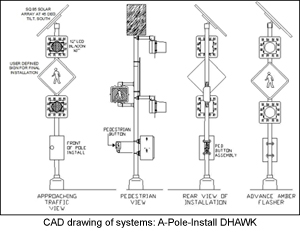
Video
Español
Get a Quote
Systems / Products
Applications
Data Sheets
Product Line
Articles / References
News Releases
Specialty Systems
Design Guides / Get Quote
AC-Powered Controls New
Area & In-Roadway Lighting
Fire Chiefs: Firefighting
High Water Sensor
Industrial
Police Chiefs
Public Works
Roadway Sensor Power
Safe Routes to School
Traffic Calming
Unusual Projects
Customer Service
Contact Us
FAQs
Send Us Your Requirements
Wireless Traffic Control Solutions: A Primer
About STC
Trade Shows & Events
Eco-Opportunity
Bio - Joe Wise
Media Fact Sheet
Links
FIRST
EVIT
Solar Electric Basics
Traffic Systems & Technology
Trafficalm Systems
Magnaray International
BarcodesInc/Electronics
| STC In The News
STC delivers distributed solar-powered Hawk Crossing System to Raytheon TEMPE, AZ - 11/02/2009 - Solar Traffic Controls has delivered and overseen installation of a variation of the solar-powered Hawk crossing signal to Raytheon Missile Systems in Tucson, AZ. Each crossing consists of four poles: two red lamp poles with pedestrian indicators and two advance amber flasher poles. All units are linked to each other via wireless link. All are solar powered. The Hawk mid-block crossing system includes red and yellow lamps along with pedestrian indicators. In standby mode, the traffic beacons appear dark to the approaching traffic while the pedestrian indicator displays a Don't Walk (DW) indication to the pedestrians. When the pedestrian button is pressed, the amber lamps go to a flashing state, followed by a solid amber display while the pedestrian indicator shows a solid DW indication. The amber lamps go dark and solid red beacons are displayed to traffic and the Walk indication is given to the pedestrian. This is followed by flashing red indications to traffic and a flashing DW indication to the pedestrian. At the conclusion of the flashing red interval, the traffic lamps go dark and the pedestrian section displays a solid DW. After the display cycle is completed the system goes into a lockout period to allow accumulated traffic to pass before another activation cycle. The distributed version of the Hawk which Raytheon chose to install was based on separating the amber lamps from the reds. The amber lamps were located 100 to 200 feet in advance of the crossings, which were all on low speed roadways within Raytheon's facility. The units located at the crosswalk consisted of a dual 12-inch red traffic indication; DC pedestrian indication; Polara Bulldog push button and STC solar-powered control circuitry. The advance units consist of 12-inch dual amber flashers with standard Solar Ped-X controls running modified software for this application. In standby, the system presents dark signals to approaching traffic and a solid DW to pedestrians. Upon activation, the advance amber lamps go into flash mode, the red lamps go solid and the DW remains solid. A field adjustable "red clear" timer was the first timing interval to run and was included to allow cars to come to a stop at the crosswalk prior to walk interval. This timer is field programmable from 3 to 20 seconds depending on vehicle speeds. During the walk interval, the advance ambers continue to flash, the reds remain solid and the walk indication is displayed to the pedestrian. The walk interval timer can be set from 10 to 60 seconds to allow some adjustment for user needs. The DW interval then follows when the pedestrian indicator shows a flashing red DW; the red lamps go to a flashing red state and the advance amber lamps continue to flash. At the conclusion of the DW interval, the traffic lamps go dark, standby state, and the DW indication goes solid. At this time the system is prevented from triggering again for a minimum of 10 seconds, programmable to 30 seconds, to allow vehicles to clear the zone prior to another activation. Even though the amber lamps are separated from the reds, the programming used is almost identical to the Solar Ped-X Hawk software which is presently under test at STC.
CAD drawings are included to help clarify the project. Due to the sensitive nature of the work at the facility and adjoining military base, photos cannot be included. About Solar Traffic Controls
|
CAGE Code 4GN91
| Site by Artique Design Works | © 2001 - 2026 Solar Traffic Controls, L.L.C. - All Rights Reserved |
 Fielding this system and managing power issues required the development of a DC pedestrian indicator. The engineering staff at STC laid out the circuit
boards and did the necessary development to ensure a reliable design as it
will be necessary for the Solar Ped-X Hawk units to be introduced in 2010.
It is projected this will be a standard product in the STC line by the end
of the first quarter, 2010. STC also developed a removable handheld
interface terminal which allows a user to adjust values and monitor the
system operation from the master control unit located at one of the red
units.
Fielding this system and managing power issues required the development of a DC pedestrian indicator. The engineering staff at STC laid out the circuit
boards and did the necessary development to ensure a reliable design as it
will be necessary for the Solar Ped-X Hawk units to be introduced in 2010.
It is projected this will be a standard product in the STC line by the end
of the first quarter, 2010. STC also developed a removable handheld
interface terminal which allows a user to adjust values and monitor the
system operation from the master control unit located at one of the red
units.